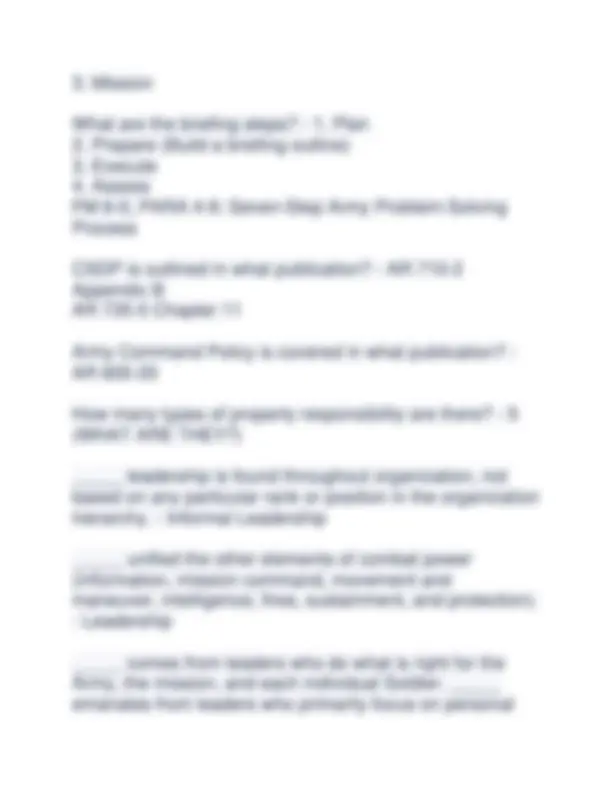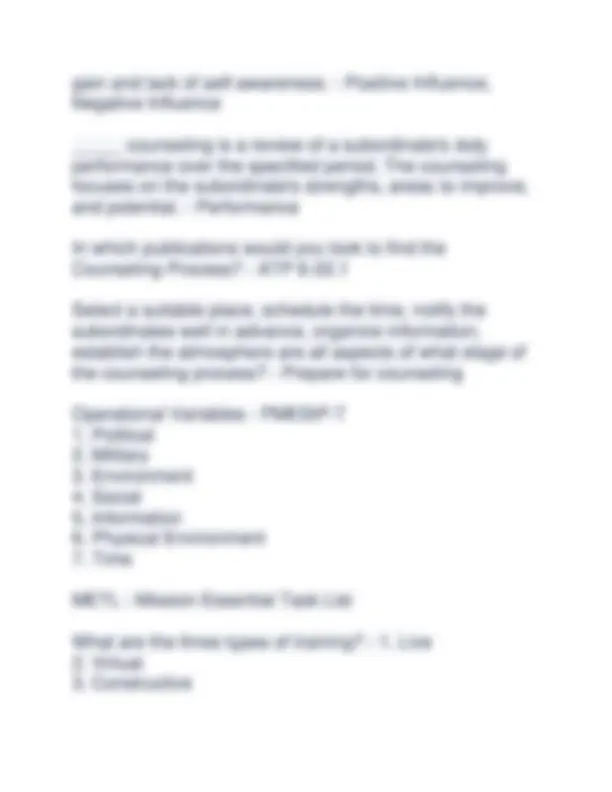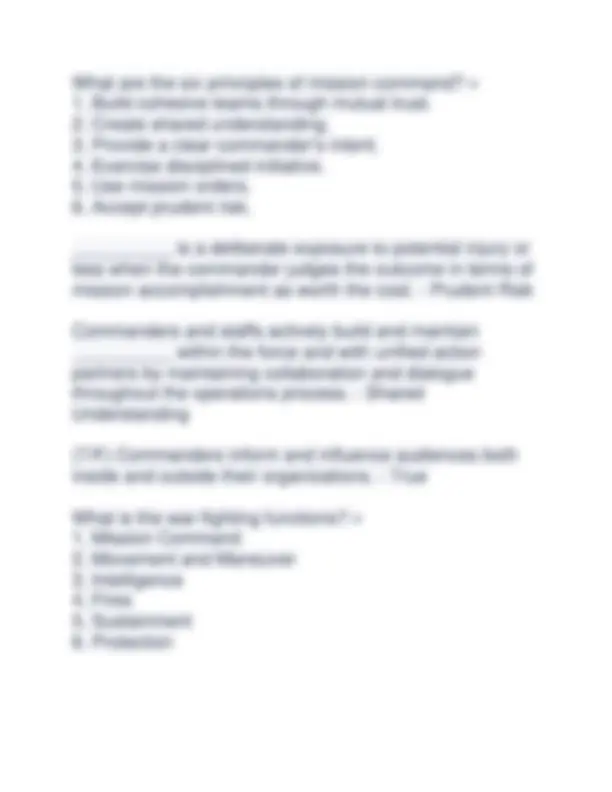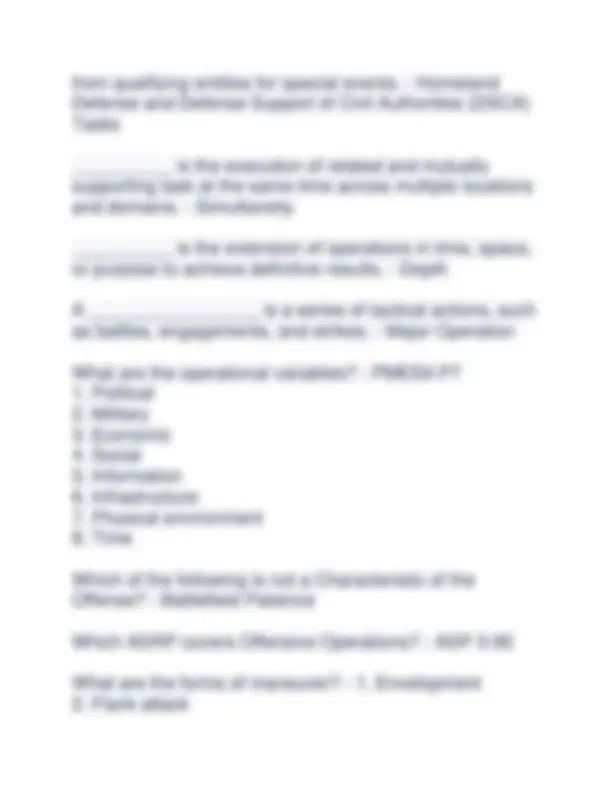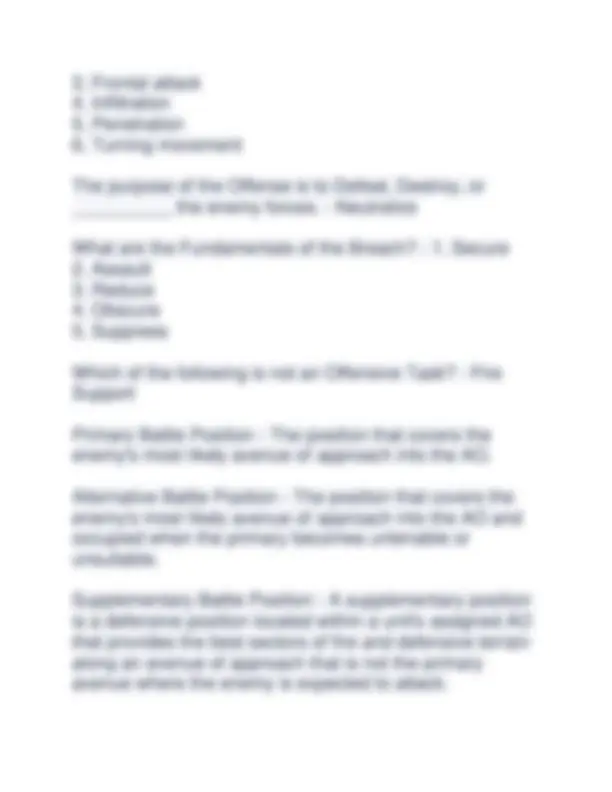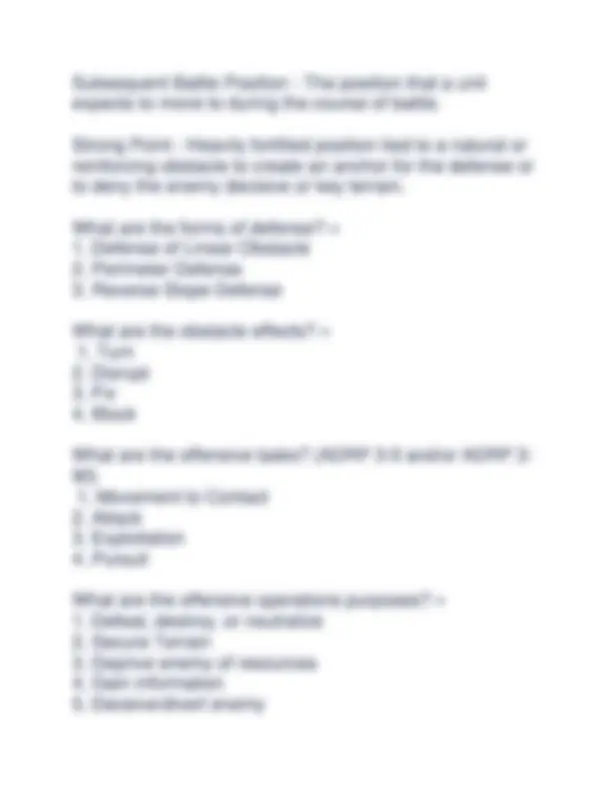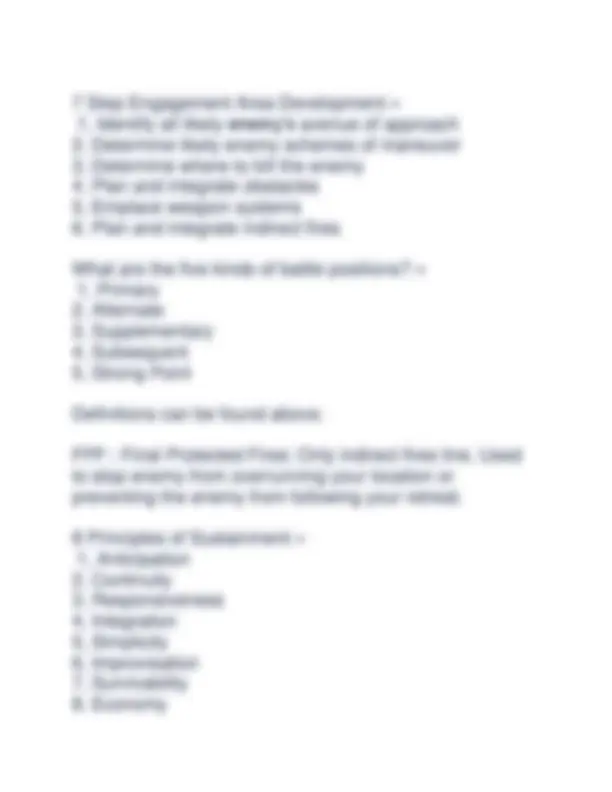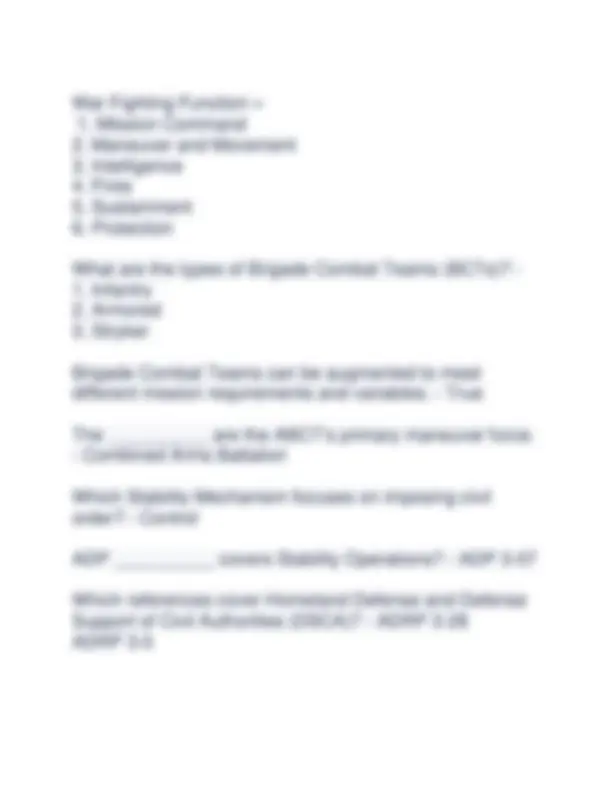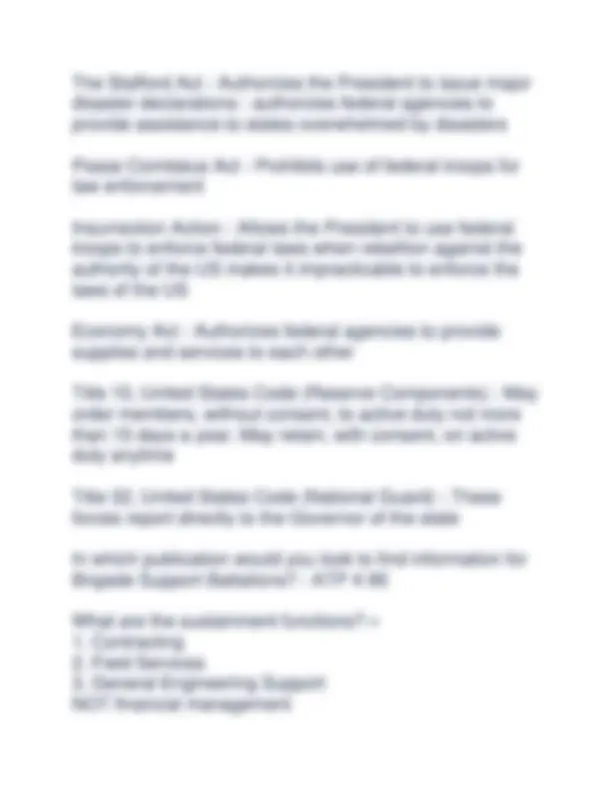Download Core Captains Career Course -
Common Final Exam and more Exams Military leadership in PDF only on Docsity!
Core Captains Career Course -
Common Final Exam
Military Decision-Making Process Steps - 1. Receive Mission
- Analyze Mission
- Develop course of action
- Analyze course of action
- Compare course of action
- Approve course of action
- Produce, disseminate orders _____ the task, together with the purpose, that clearly indicates the action to be taken and the reason therefore. - Mission Statement _____ succinctly describes what constitutes success for the operation. - Commanders Intent (T/F) The Army's framework for exercising Mission Command is the Operations Process. - True Planners should consider the following major resources: - Land, Facilities, Ranges, Ammunition, TADSS, OPFORS, Role Players, and Master Scenario Event (All of the above)
Unit Commanders should utilize the Operations Process for conducting training events. These steps include: - Plan, Prepare, Execute, Assess (All of the above) FM 7-0 states that a ________ supports the higher commander's guidance and supports training the unit to the selected METs. - Unit Training Plan __________ is a required automated system used to assist the Commander in planning, resourcing, and tracking individual and collect unit training tasks. - Digital Training Management System (DTMS) What is the second step of the MDMP? - Mission Analysis Which of the following is not an Army principle of leader development? - Train leaders in the art of Mission Analysis _____ and _____ are the two types of evaluations per FM 7 - 0. - Formal and Informal According to FM 7-0, which is NOT a principle of Army Training? - Noncommissioned officers train individuals, crews, and small teams. The primary portal to Unit Training Management (UTM) is through the Army Training Network (ATN). - True What are the three different types of briefs? - 1. Information
- Decision
gain and lack of self-awareness. - Positive Influence, Negative Influence _____ counseling is a review of a subordinate's duty performance over the specified period. The counseling focuses on the subordinate's strengths, areas to improve, and potential. - Performance In which publications would you look to find the Counseling Process? - ATP 6-22. Select a suitable place, schedule the time, notify the subordinates well in advance, organize information, establish the atmosphere are all aspects of what stage of the counseling process? - Prepare for counseling Operational Variables - PMESIP-T
- Political
- Military
- Environment
- Social
- Information
- Physical Environment
- Time METL - Mission Essential Task List What are the three types of training? - 1. Live
- Virtual
- Constructive
What are the six principles of mission command? –
- Build cohesive teams through mutual trust.
- Create shared understanding.
- Provide a clear commander's intent.
- Exercise disciplined initiative.
- Use mission orders.
- Accept prudent risk. __________ is a deliberate exposure to potential injury or less when the commander judges the outcome in terms of mission accomplishment as worth the cost. - Prudent Risk Commanders and staffs actively build and maintain __________ within the force and with unified action partners by maintaining collaboration and dialogue throughout the operations process. - Shared Understanding (T/F) Commanders inform and influence audiences both inside and outside their organizations. - True What is the war-fighting functions? –
- Mission Command
- Movement and Maneuver
- Intelligence
- Fires
- Sustainment
- Protection
- Terrain and Weather
- Troops and Support Available
- Time Available,
- Civil Considerations Known as METT-TC (T/F) Land operations are straightforward because Decisive Action ensures separation of enemy, adversary, neutral, and friendly, with easy to distinguish characteristics. - FALSE __________ are conducted to defeat an enemy attack, gain time, economize forces, and develop conditions favorable for offensive and stability tasks. - Defensive Tasks What are the tasks that make up Decisive Action according to doctrine? - 1. Offensive Tasks
- Defensive Tasks
- Stability Tasks
- Homeland Defense/Defense Support of Civil Authorities (DSCA) __________ is the arrangement of military actions in time, space, and purpose to produce maximum relative combat power at a decisive place and time. - Synchronization __________ represent Department of Defense support to U.S. civil authorities for domestic emergencies, law enforcement support, and other domestic activities, or
from qualifying entities for special events. - Homeland Defense and Defense Support of Civil Authorities (DSCA) Tasks __________ is the execution of related and mutually supporting task at the same time across multiple locations and domains. - Simultaneity __________ is the extension of operations in time, space, or purpose to achieve definitive results. - Depth A _________________ is a series of tactical actions, such as battles, engagements, and strikes. - Major Operation What are the operational variables? - PMESII-PT
- Political
- Military
- Economic
- Social
- Information
- Infrastructure
- Physical environment
- Time Which of the following is not a Characteristic of the Offense? - Battlefield Patience Which ADRP covers Offensive Operations? - ADP 3- 90 What are the forms of maneuver? - 1. Envelopment
- Flank attack
Subsequent Battle Position - The position that a unit expects to move to during the course of battle. Strong Point - Heavily fortified position tied to a natural or reinforcing obstacle to create an anchor for the defense or to deny the enemy decisive or key terrain. What are the forms of defense? –
- Defense of Linear Obstacle
- Perimeter Defense
- Reverse Slope Defense What are the obstacle effects? –
- Turn
- Disrupt
- Fix
- Block What are the offensive tasks? (ADRP 3-0 and/or ADRP 3-
- Movement to Contact
- Attack
- Exploitation
- Pursuit What are the offensive operations purposes? –
- Defeat, destroy, or neutralize
- Secure Terrain
- Deprive enemy of resources
- Gain information
- Deceive/divert enemy
- Hold enemy position
- Disrupt enemy attack Characteristics of the Offense –
- Surprise
- Concentration: Massing of overwhelming effects of combat power to achieve a single purpose
- Tempo: Controlling or altering tempo is necessary to retain the initiative
- Audacity: Boldly executing a simple plan of action. This can be displayed be developing bold, inventing plans that produce decisive results and/or by violently applying combat power. Forms of Maneuver (ADRP 3 - 90, Chapter 3) –
- Envelopment
- Turning Movement
- Infiltration
- Penetration
- Frontal Attack
- Flank Attack Tactical Enabling Tasks –
- Reconnaissance
- Security Operations
- Troop Movement
- Relief in Place
- Passage of lines
- Encirclement Operations
- Passage of Lines: Force moves through another force's combat positions to; sustain tempo, maintain visibility of
7 Step Engagement Area Development –
- Identify all likely enemy’s avenue of approach
- Determine likely enemy schemes of maneuver
- Determine where to kill the enemy
- Plan and integrate obstacles
- Emplace weapon systems
- Plan and integrate indirect fires What are the five kinds of battle positions? –
- Primary
- Alternate
- Supplementary
- Subsequent
- Strong Point Definitions can be found above. FPF - Final Protected Fires: Only indirect fires line. Used to stop enemy from overrunning your location or preventing the enemy from following your retreat. 8 Principles of Sustainment –
- Anticipation
- Continuity
- Responsiveness
- Integration
- Simplicity
- Improvisation
- Survivability
- Economy
War Fighting Function –
- Mission Command
- Maneuver and Movement
- Intelligence
- Fires
- Sustainment
- Protection What are the types of Brigade Combat Teams (BCTs)? -
- Infantry
- Armored
- Stryker Brigade Combat Teams can be augmented to meet different mission requirements and variables. - True The __________ are the ABCT's primary maneuver force.
- Combined Arms Battalion Which Stability Mechanism focuses on imposing civil order? - Control ADP __________ covers Stability Operations? - ADP 3- 07 Which references cover Homeland Defense and Defense Support of Civil Authorities (DSCA)? - ADRP 3- 28 ADRP 3- 0
What are the four basic principles of the Law of Armed Conflict (LOAC)? –
- Military Necessity
- Proportionality
- Discrimination or Distinction
- Unnecessary Suffering Symbols protected under the Geneva Convention –
- Red Cross
- Red Crescent
- Red Crystal

